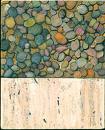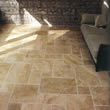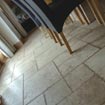What is Travertine?
 Travertine tile is a natural material that has unique features that no other stone can offer. Travertine is a relatively hard stone. The distinctive design of Travertine creates some of the most distinguished floor tiles. The stone is characterized by tiny crevices, pitted holes and veins of contrasting color. Travertine is ideal for commercial and residential use. It can be used for floor tile, kitchen flooring, bathroom wall tile, bathroom floor tile, and it is often used externally. Travertine tile is a natural material that has unique features that no other stone can offer. Travertine is a relatively hard stone. The distinctive design of Travertine creates some of the most distinguished floor tiles. The stone is characterized by tiny crevices, pitted holes and veins of contrasting color. Travertine is ideal for commercial and residential use. It can be used for floor tile, kitchen flooring, bathroom wall tile, bathroom floor tile, and it is often used externally.
While travertine has been extensively quarried in Iran, it is also mined in Afghanistan, China, Greece, Guatemala, Italy, Mexico, Peru, Turkey and the US. Once it has been quarried it is cut for use in construction. Travertine can be ordered in various thicknesses. Travertine tile will vary in quality, density, porosity and hardness. These qualities should be considered in conjunction with their intended use. High traffic and outdoor applications, for example, should use a harder stone.
 Travertine is a form of massive calcium carbonate, CaCO 3 , resulting from deposition by springs or rivers. It is often beautifully colored and banded as a result of the presence of iron compounds or other (e.g., organic) impurities. This material is variously known as calc-sinter and calcareous tufa (when used for decorative purposes), in fact Travertine is actually a dense closely compacted form of limestone. Travertine is a form of massive calcium carbonate, CaCO 3 , resulting from deposition by springs or rivers. It is often beautifully colored and banded as a result of the presence of iron compounds or other (e.g., organic) impurities. This material is variously known as calc-sinter and calcareous tufa (when used for decorative purposes), in fact Travertine is actually a dense closely compacted form of limestone.
 Travertine is an excellent product for residential and commercial use and is becoming increasingly popular because not only does it have the elegant look of marble, but also once sealed Travertine tiles require very little maintenance, which allows for a timeless & beautiful appearance. Travertine is an excellent product for residential and commercial use and is becoming increasingly popular because not only does it have the elegant look of marble, but also once sealed Travertine tiles require very little maintenance, which allows for a timeless & beautiful appearance.
Travertine is available in a number of finishes ranging from polish, cross-cut, regular-cut, honed & filled, honed & unfilled, tumbled, distressed-edge, patinato and unpolished to name a few.
Travertine tile possess a wide range of colors, and cover the spectrum from pure white to deep mahogany. The various hues of Travertine tile can sometimes be constant throughout large pieces and at times are blended. Travertine tile displays distinct veins at times and is a very sturdy natural stone.
Travertine's Appearance
 The surface of Travertine is pitted with tiny, irregular holes and generally has ribbons or bands of color running through the tile. The surface of Travertine is pitted with tiny, irregular holes and generally has ribbons or bands of color running through the tile.
Pure, white travertine is rare. More often the stone is colored because iron or naturally occurring organic impurities affected the stone while it was forming. The stone comes in a wide range of warm colors that can work with different design palates. The color could be anywhere from white, cream, tan, brown, golden, or caramel to a yellow, red or gray.
Travertine Applications:
From small mosaics to large slabs, travertine stone tiles are used for:
- Kitchen Floors
- Kitchen Backsplashes
- Counters
- Entryway Floors
- Interior Walls
- Outdoor Walls
- Fireplace Surrounds
- Bathroom Floors
- Bathroom Walls and Backsplashes
- Tub Surrounds
- Outdoor Patios and Walkways
Travertine is also used in making statues, sinks, vanities, tables, coasters and other decorative items.
Grouting Travertine:
 When it comes time to grout you will have to decide on the look you prefer. There are two techniques for grouting the travertine. The naturally existing holes can be Filled or left Unfilled. This is also called Antique Fill or Natural Look. When you plan to fill the holes the grout you select should be color-matched to the tile. The holes can also be filled with dust resin or an epoxy. When it comes time to grout you will have to decide on the look you prefer. There are two techniques for grouting the travertine. The naturally existing holes can be Filled or left Unfilled. This is also called Antique Fill or Natural Look. When you plan to fill the holes the grout you select should be color-matched to the tile. The holes can also be filled with dust resin or an epoxy.
Some favor the natural, warm look of the open holes, whereas others fancy the more polished, finished look of the filled holes. Whichever option you choose, the job is made easier by sealing the tiles first before you grout.
Sealing and Cleaning Travertine:
 When you want unfilled holes, use the sealer generously to fill the holes and when grouting prevent the grout from depositing in the holes. For the filled holes, just brush the surface of the tile with your sealant. The grout will still be able to fill the holes, but it will be easy to wash the grout off the travertine's surface. When you want unfilled holes, use the sealer generously to fill the holes and when grouting prevent the grout from depositing in the holes. For the filled holes, just brush the surface of the tile with your sealant. The grout will still be able to fill the holes, but it will be easy to wash the grout off the travertine's surface.
Sealing the travertine serves to protect the stone. It can also enhance the color of stone and provide either a glossy or matte finish. The choice is yours.
Caution: When cleaning your travertine floors do not use vinegar, an acidic or an abrasive cleaner, so as not to scratch or discolor it. Make sure you wipe up spills as soon as they happen. Sweep or dust mop the floors frequently and mop the floors with a neutral cleaner or a stone soap. Rinse and dry the tile after using the soap.
Choosing a material

There are several types of finish available so this versatile material can suit almost any application from "rustic" to contemporary. The surface appearance of the tile depends on the cutting technique at the quarry. Tiles are either cut with the natural grain of the stone or contra cut against the natural grain. The former giving a linear movement in the surface markings, the latter giving more variegated markings in a non linear format.
Travertine tiles are quite variable so it's important to see an actual area as a single sample will never give the true picture of this material.
Filled or Unfilled?
 We are regularly asked what does this mean. As we explained earlier one of the characteristics of Travertine tiles are the voids in the surface which are a feature of this material. These can vary from literally pinholes to quite large irregular holes. These voids can be filled with grout when fixing the tiles or filled at the factory. and the tile machined to give a honed or polished surface. We are regularly asked what does this mean. As we explained earlier one of the characteristics of Travertine tiles are the voids in the surface which are a feature of this material. These can vary from literally pinholes to quite large irregular holes. These voids can be filled with grout when fixing the tiles or filled at the factory. and the tile machined to give a honed or polished surface.
Factory filled and honed tiles are usually more expensive than unfilled however this depends on the finish, brushed tiles cannot be filled and are desirable due to their "rustic" appearance. As with all things quality can vary dramatically as Travertine are often graded into quality groups such as Select and 2nd choice. We do not stock 2nd choice quality as the quality is so variable, many of the cheap offers on this material fall into this category (but they are not going to tell you that are they?)
It is possible for holes to appear in filled Travertine usually when they are on the floor and in relative high traffic areas. This is usually caused by the filling breaking down. It’s not as bad as it sounds but it can happen regardless of the quality of material although the better materials have less filling so this is consequently minimized. These voids can be filled using a suitable Grout or an Epoxy Resin. The easy method is to simply fill the void with a matching grout usually the same as was used between the tiles when they were fixed. It is impossible to guarantee that voids will never occur with filled tiles.
As with all natural materials shade and surface appearance can vary quite considerably however the larger the area the less noticeable this becomes and in many cases it is desirable as a feature of this type of material.
If your project is for a reasonable area its worth taking the time to have a look at the actual material you are considering as it is impossible to choose correctly from a sample tile.
Types of finish for Travertine tiles
Polished Available only with filled tiles
Honed Available in either filled or unfilled
Brushed A textured finish available unfilled tiles only
Tumbled This process of involves acidic based chemicals at the factory level and/or the use of a tumbling machine that "antiques" the stone to give the appearance of a weathered, antique look in the stone, with softened edges.
Antiqued Acid washed to create the tumbling effect, then brushed to "smooth" the surface.
Bush hammered - tiny pins are "hammered" on the surface of the stone to create a coarse, slip resistant texture on the surface.
Sandblasted - This process creates a coarse, but consistent surface often used for slip-resistant applications, or other decorative designs.
Natural Cleft - Most commonly associated with slate, the tiles are cleft naturally from the blocks to create natural ridges in the surface. In most cases, natural cleft slate products will be gauged (or milled) on the underside for easy installation, but the natural cleft will be evident on the exposed surface.
Split Face (or Rock Face) - This process involved splitting stone with a guillotine like machine to create a look as if it was an exposed rock in nature, but processed in dimensions suitable for architectural settings.
Chiseled Hand or machine chiseled surfaces create a surface similar to the split face stone, but typically leave chisel marks in the surface (not on chiseled edge finishes though)
|

